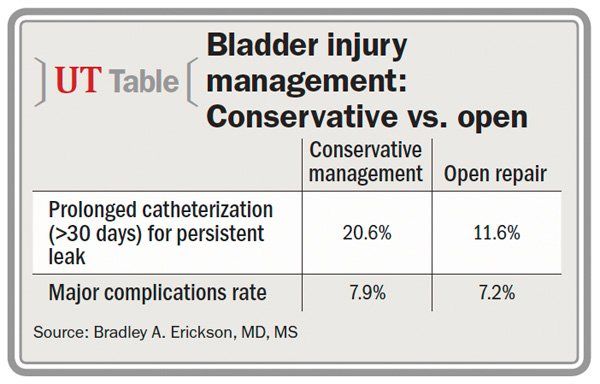Article
Ideal bladder injury treatment modality unclear
There has been a movement favoring noninvasive and minimally invasive approaches for management of urologic trauma cases, but findings from a multi-institutional retrospective study indicate that at least for patients with extraperitoneal bladder injury, evidence-based data are needed to justify that trend.
Iowa City, IA-There has been a movement favoring noninvasive and minimally invasive approaches for management of urologic trauma cases, but findings from a multi-institutional retrospective study indicate that at least for patients with extraperitoneal bladder injury, evidence-based data are needed to justify that trend.

Dr. EricksonTo investigate the idea that open surgical repair for extraperitoneal bladder injury may be underutilized as conservative management becomes more routine, study co-author Bradley A. Erickson, MD, MS, and colleagues compared outcomes of patients managed with these two approaches for a solitary extraperitoneal bladder injury (ie, no bladder neck or intraperitoneal component).
The review, presented at the 2013 American College of Surgeons Clinical Congress in Washington, identified 195 patients treated over a 16-year period at four Level 1 trauma centers located across the United States. Of the 195 patients, 82% had blunt injuries and 18% had penetrating trauma. Initial management was open repair in 35% of cases, including all patients with penetrating injuries, and conservative, with only placement of a Foley catheter, in 65% of patients. However, 20% of patients who were initially managed conservatively were ultimately converted to open repair, including eight patients who underwent open repair because of unmanageable leaks (6% of the total conservative cases).
Prolonged catheterization (>30 days) for persistent leak, which was analyzed as the primary outcome variable, occurred at a twofold higher rate among patients who had initial conservative management than in the initial open repair group (20.6% vs. 11.6%), although the difference between groups only showed a trend toward statistical significance (p=.11).

Continue to next page for more.
Incidence of major complications, defined as events requiring surgical intervention, was investigated as the secondary outcome and found to be slightly more common in the conservative management group compared with the open repair group (7.9% vs. 7.2%).
“Our study does not provide any definitive answers about what type of extraperitoneal bladder injury needs to be repaired in an open manner and which can be observed,” said Dr. Erickson, assistant professor of urology at the University of Iowa, Iowa City.
“However, we do believe that extraperitoneal bladder injuries should always be addressed with open repair when the patient is already being taken to surgery for comorbid trauma. Outside of those situations, we believe our study highlights the need for a randomized trial comparing open repair and conservative management. Performing such a study would require only a moderate degree of effort.”
Possible selection bias
Dr. Erickson noted that while the findings from the retrospective analysis did not support the investigators’ hypothesis that significant differences would be found favoring open repair over conservative management, selection bias was a confounding factor.
“We could not reliably assess bladder injury severity from our data, but it is likely the patients with the worst injuries underwent open repair while those with more minor injuries received conservative management. And despite this presumed difference in severity, major complication rates were similar between the two groups,” he explained.UT
Like this article? Check out these other recent Urology Times articles:
Labial, lingual mucosa grafts viable for urethroplasty
Alternative grafts: Beyond buccal mucosa
Urethral stricture: Two factors drive complication risk
Subscribe to Urology Times to get monthly news from the leading news source for urologists.















